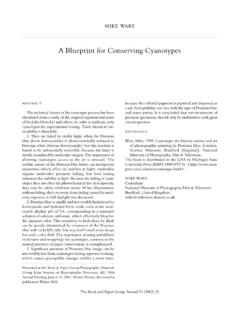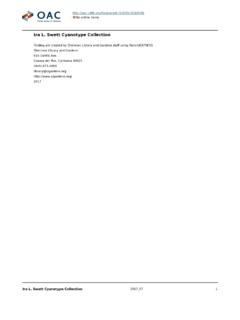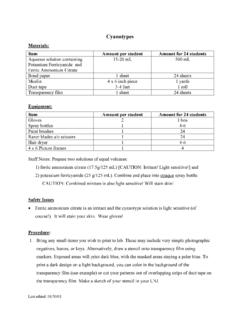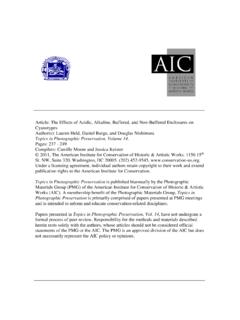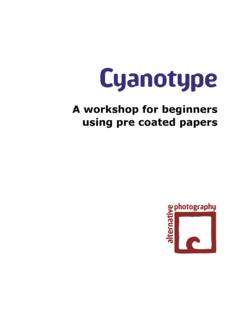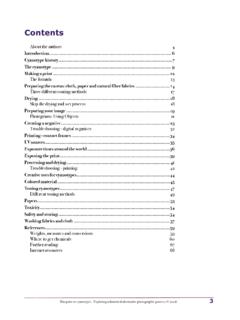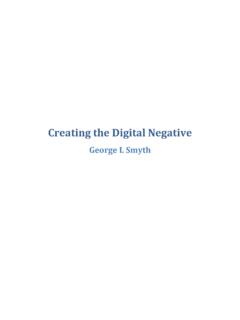Transcription of LESSON OVERVIEW: STANDARDS - fristartmuseum.org
1 Teacher: Class: 1 Class Period Course Unit: LESSON Title: Solar Powered Prints LESSON OVERVIEW: Summary of the task, challenge, investigation, career-related scenario, problem, or community link. This LESSON will allow students to explore the basics of the photographic process by creating their own cyanotype print using found objects. A cyanotype is a photographic print made by placing objects directly onto light sensitive paper and then exposing the paper to light. Students will use a minimum of four objects to create an interesting composition on a 4 x5 piece of photosensitive paper. Students will place their composition in the sun and will watch how the sunlight develops their photograph by turning exposed areas blue and leaving covered areas white.
2 STANDARDS : Identify what you want to teach. Reference State, Common Core, ACT Readiness STANDARDS and/or State Competencies. Tennessee State STANDARDS Manipulate a variety of tools and media in a safe and responsible manner. Apply principles of design. Create works of art with an intended purpose or combination of purposes. Select and demonstrate subject matter, symbols, and ideas in one s art. Analyze and discuss the characteristics and merits of one s own artwork. Analyze and discuss the characteristics and merits of artwork of others. Common Core Connections for Integrated Subject-Writing, Speaking & Listening, Science Write informative/explanatory texts to examine a topic and convey ideas and information clearly.
3 Engage effectively in a range of collaborative discussions (one-on-one, in groups, and teacher-led) with diverse partners on grade 4 topics and texts, building on others ideas and expressing their own clearly. Review the key ideas expressed and explain their own ideas and understanding in light of the discussion. GLE Recognize that the position of an object can be described relative to other objects or a background. GLE Identify appropriate materials, tools, and machines that can extend or enhance the ability to solve a specified problem. OBJECTIVE: Clear, Specific, and Measurable-NOT ACTIVITIES. Student-friendly. 1. Students will be able to create a cyanotype print by arranging found objects onto photosensitive paper and exposing that paper to direct sunlight.
4 2. Students will be able to discuss how the cyanotype process worked and how various factors such as exposure time, brightness of the sun, and arrangement of their objects, affected their results. 3. Students will be able to compare and contrast the cyanotype exposure process versus the exposure process that requires chemicals and a darkroom. 4. Students will use the principles of design to create an interesting composition with their chosen found objects. ASSESSMENT/EVALUATION: Students show evidence of proficiency through a variety of assessments. Aligned with the LESSON Objective. 1. Students will be introduced to and apply the principles of design to the formation of their composition.
5 2. In a written response students will explain the basic steps of creating a cyanotype print. 3. Students will present their print in a class critique and will discuss how they arranged their found objects to create an interesting composition. MATERIALS: Aligned with the LESSON Objective. Rigorous and Relevant. (1) Tedco Sun Art Paper Kit- the kit contains 15 8 x10 sheets which should be cut in half so that each student will have 1 4 x5 piece of photosensitive paper. The kit also contains clear acrylic sheets to hold the objects in place on top of the photosensitive paper. (5) 8 x10 Trays filled with water (4) Found objects per student (1) Piece of 4 x5 drawing paper per student ACTIVATING STRATEGY: Motivator/Hook.
6 An Essential Question encourages students to put forth more effort when faced with complex, open-ended, challenging, meaningful, and authentic questions. 1. Show examples of cyanotypes and explain that they are created by arranging objects on photosensitive paper that is then exposed to sunlight. 2. Show examples of darkroom photography and explain the basic process of developing prints in a darkroom. Inform students that cyanotypes are an easy alternative to photographic methods that require chemicals and a darkroom. 3. Explain that photographs are composed using the principles of design: emphasis, balance, contrast, and repetition.
7 4. Ask students to point to each of these principles in the examples provided. INSTRUCTION: Step-By-Step Procedures-Sequence. Discover/Explain-Direct Instruction. 1. The teacher will introduce the LESSON with a pre-made example and will state the objectives. 2. In the weeks prior to this LESSON students will bring in found objects/materials such as buttons, magnets, grass, and leaves to add to a class collection. 3. The teacher will explain that before going outside students will choose objects from the class collection and will practice arranging their objects on a 4 x5 piece of drawing paper. 4. The teacher will explain that when they are outside students will see a shaded area that contains 5 8 x10 pans of water.
8 The shaded area will be where students arrange their objects before exposing them and it will be where students rinse their papers after exposure. 5. The class will review rules for going outside and will follow the teacher to the designated area for this project. 6. Students will arrange their objects on the photosensitive paper in the shade and will then place the paper in the sunlight for a total of five minutes. 7. After exposing their paper for five minutes students will return to the shaded area and will rinse their paper in the 8 x10 pan of water. 8. Once each student has rinsed their print the class will return to the classroom to allow their prints to dry.
9 ALTERNATE/EXTRA ACTIVITIES: 1. If students are unable to go outside for the exposure process, the objects could be taped to the photosensitive paper and the paper could then be taped to a window that receives direct sunlight. 2. If a shaded area is unavailable outside, the teacher will carry the photosensitive paper in the protective bag and will pass it out to each student once outside. The students will have their objects ready and will quickly arrange them on the paper. CLOSURE: Reflection/Wrap-Up. Summarizing, Reminding, Reflecting, Restating, Connecting. 1. During the class critique ask students to describe how factors such as exposure time and brightness of the sun affected their final piece.
10 During this time students will also explain how they created an interesting composition. 2. Remind students of other photography exposure techniques and in a written response students will compare and contrast the cyanotype method with other traditional methods. CROSS-CURRICULAR CONNECTIONS 1. Writing 2. Speaking and Listening 3. Science EXTENDED LEARNING Books: 1. Imogen: The Mother of Modernism and Three Boys by Amy Novesky and Lisa Congdon 2. Cameras for Kids: Fun and Inexpensive Projects for the Little Photographer by John Crippen 3. Walker Evans: Photographer of America by Thomas Nau 4. Restless Spirit: The Life and Work of Dorothea Lange by Elizabeth Partridge 5.
